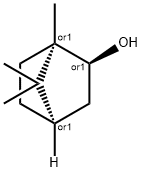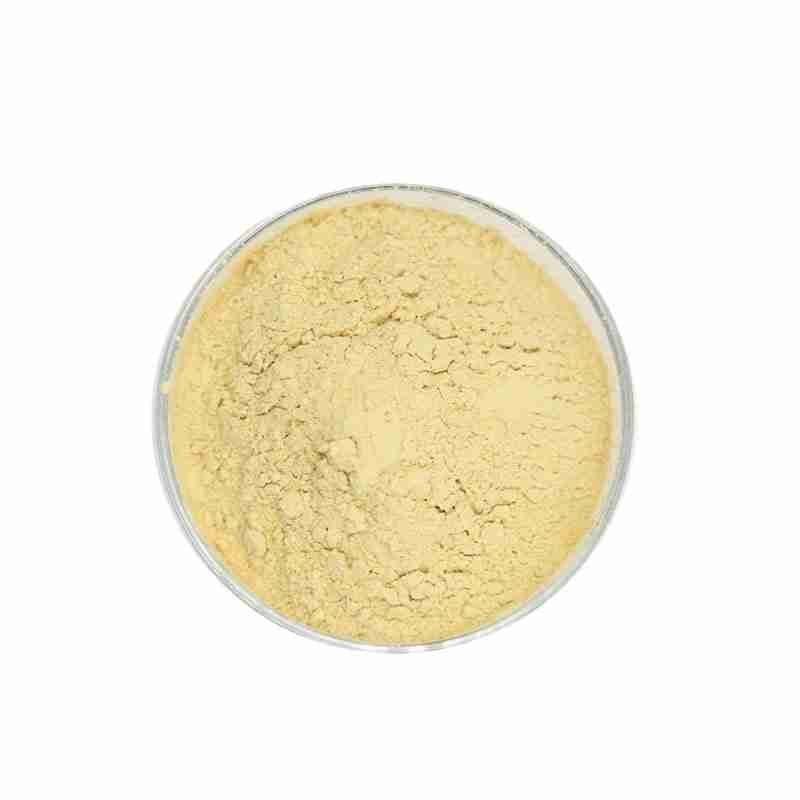Borneol CAS# 507-70-0
Borneol, other names: dipterocarp, brain, pellets, plum blossom brain, natural borneol, old plum slices, plum slices. Main ingredients: This product is a crystal obtained from the resin and volatile oil of dipterocarps. It is almost pure dextrorotary borneol. The resin and volatile oil of Dipterocarps contain a variety of terpenes. In addition to borneol, it also contains sesquiterpenes such as humulene, ??-elemene, and caryophyllene, as well as oleanolic acid, malic acid, asiatic acid, borneol ketone, borneol diol ketone, and archaic acid. Triterpene compounds such as codiol.
发送询盘
Borneol CAS# 507-70-0
| Borneol Basic information |
| Description?References |
| Product Name: | Borneol |
| Synonyms: | (1R,2S,4R)-rel-1,7,7-TriMethylbicyclo[2.2.1]heptan-2-ol;Endo-1,7,7-trimethyl-bicyclo[2.2.1]heptan-2-ol 2-Camphanol;1,7,7-Trimethyl-bicyclo(2.2.1)heptan-2-ol, endo-;1,7,7-trimethyl-endo-Bicyclo[2.2.1]heptan-2-ol;2-Bornanol, endo-;L-BORNEO CAMPHOR;L-BORNYL ALCOHOL;L-2-HYDROXYBORNANE |
| CAS: | 507-70-0 |
| MF: | C10H18O |
| MW: | 154.25 |
| EINECS: | 208-080-0 |
| Product Categories: | standardized herbal extract;Inhibitors;Monoterpenoids;Biochemistry;Terpenes;Alcohols;C9 to C30;Oxygen Compounds;Bicyclic Monoterpenes;chemical reagent;pharmaceutical intermediate;phytochemical;reference standards from Chinese medicinal herbs (TCM).;Pharmaceutical;Intermediate |
| Mol File: | 507-70-0.mol |
 |
|
| Borneol Chemical Properties |
| Melting point | 206-209???C |
| Boiling point | 210???C(lit.) |
| alpha | -0.5??+0.5?b(20??/D)(c=5,C2H5OH) |
| density | 1.011 |
| vapor density | 5.31 (vs air) |
| vapor pressure | 33.5 mm Hg ( 25 ??C) |
| refractive index | 1.4831 (estimate) |
| FEMA | 2157 | BORNEOL |
| Fp | 150???F |
| solubility | DMSO:30.0(Max Conc. mg/mL);194.49(Max Conc. mM) Ethanol:30.0(Max Conc. mg/mL);194.49(Max Conc. mM) |
| form | powder to crystal |
| pka | 15.36??0.60(Predicted) |
| color | White to Almost white |
| Odor | at 10.00 % in dipropylene glycol. pine woody camphor balsamic |
| Odor Type | balsamic |
| Water Solubility | insoluble |
| JECFA Number | 1385 |
| Merck | 14,1338 |
| Stability: | Stable. Highly flammable. Incompatible with strong oxidizing agents. |
| InChIKey | DTGKSKDOIYIVQL-WEDXCCLWSA-N |
| LogP | 3.6 at 20?? |
| CAS DataBase Reference | 507-70-0(CAS DataBase Reference) |
| NIST Chemistry Reference | Borneol(507-70-0) |
| EPA Substance Registry System | Borneol (507-70-0) |
- 2
- 2-diallylpent-4-en-1-amine
- 4
- 95-16-9
- Ammonium sulfamate
- Benzothiazole
- cas:67889-00-3ح2
- cas:83524-75-8 | pigment black 32
- cas:928836-00-4 | 2
- cas:932745-70-5 | 4
- Chemical Minerals
- Coconut diethanolamide
- Daily Chemicals
- discount
- for sale
- General pvc resin
- hexyl D-glucoside
- in stock
- Lauramidopropyl betaine
- LAURIC ACID MONOETHANOLAMIDE
- Petroleum Additives
- Plasticiser
- Ploymers
- price
- PVC
- quotation
- Raw Materal
- Remove term: Petroleum Additives Petroleum Additive
- SODIUM ETHYL 2-SULFOLAURATE
Related Products
Chemical Name: Dehydrocholic acid
Synonyms: Acide dehydrocholique; Triketocholanic acid
CAS No.: 81-23-2
Molecular Formula: C24H34O5
Molecular Weight: 402.53
Appearance: Powder
Chemical Name: Zinc citrate
Synonyms: Zinc citrate trihydrate
CAS No.: 546-46-3
Molecular Formula: C6H8O7Zn
Molecular Weight: 257.5
Appearance: White powder
Octocrylene is an organic compound widely recognized for its potent UV-filtering properties, making it an essential ingredient in sunscreens and other skincare products designed to protect the skin from harmful ultraviolet radiation. With the chemical name 2-(4-Methylbenzyl)-2H-benzotriazole-5-methyl, octocrylene is a stable and photostable molecule that provides broad-spectrum protection against both UVA and UVB rays.
This oil-soluble chemical is valued for its ability to absorb UV radiation effectively, converting it into heat without causing skin irritation or staining clothes. Octocrylene is often used in combination with other UV filters to enhance the sun protection factor (SPF) of formulations, ensuring a balanced and comprehensive defense against sun damage.
As a lipophilic compound, octocrylene is compatible with various cosmetic and dermatological formulations, contributing to the development of lightweight, non-greasy sunscreens. Its chemical structure allows for a high degree of safety and efficacy, making it suitable for a wide range of skin types, including sensitive skin.
In summary, octocrylene is a reliable and efficient UV filter, pivotal in the formulation of modern sunscreens that offer advanced protection against the sun’s harmful effects while maintaining skin comfort and product aesthetics.
Product name:HYDROXYPROPYL GUAR HYDROXYPROPYLTRIMONIUM CHLORIDE
Purity:99%
Appearance:Light Yellow Powder
Package:Customized according to customer needs.
Sample:Available
Chemical Name: o-Xylene
Synonyms: 1,2-Dimethylbenzene; ortho-xylene
CAS No.: 95-47-6
Molecular Formula: C8H10
Molecular Weight: 106.17
Chemical Name: Choline salicylate
CAS No.: 2016-36-6
Molecular Formula: C12H19NO4
Molecular Weight: 241.28
Appearance: Red-Brown Crystal
Chemical Name: 3-Hydroxybutyric acid
CAS No.: 625-71-8
Molecular Formula: C4H8O3
Molecular Weight: 104.1
Appearance: White powder
Ethylhexyl Palmitate is a skin-conditioning ester, derived from ethylhexanol and palmitic acid, that imparts moisturization and a smooth texture to cosmetic and personal care formulations. It is valued for its emollient properties, enhancing the sensory experience of skin care products.
Benzothiazoles are a class of chemical compounds characterized by a fused benzene and thiazole ring. They exhibit a broad spectrum of applications, particularly as antioxidants in rubber and plastic industries, enhancing product longevity and performance. Additionally, benzothiazoles serve as key intermediates in the synthesis of pharmaceuticals, contributing to the development of life-saving drugs. Recognized for their stability and reactivity, these compounds are integral to advancing material science and healthcare solutions.
1-Octanol, also known as Capryl alcohol or n-Octanol, is a clear, colorless liquid with a characteristic waxy odor. It is an alcohol with eight carbon atoms in its chain, making it a part of the aliphatic alcohol family. This compound is poorly soluble in water but is miscible with ethanol, diethyl ether, and chloroform . It has a melting point of approximately -15??C and a boiling point of around 196??C . 1-Octanol is used in the production of esters, plasticizers, and as a solvent or intermediate in the synthesis of various organic compounds. It also finds application in the fragrance industry as a fixative in perfumes and can be used in the formulation of flavor and scent compositions . It is important to note that 1-Octanol is flammable and should be handled with care, storing it away from sources of ignition and heat .
Silicones are a family of synthetic polymers known for their versatility and stability. They are heat-resistant, non-toxic, and have excellent electrical insulation properties. Commonly used in various industries such as construction, automotive, aerospace, and personal care products, silicones offer a wide range of applications from sealants and adhesives to lubricants and medical devices. Their resistance to extreme temperatures and weathering makes them a preferred choice for many high-performance applications.
3,4-Ethylenedioxythiophene is a synthetic organic compound characterized by its unique structure that includes a thiophene ring with ethylenedioxy substituents at the 3 and 4 positions. This compound is known for its potential applications in the synthesis of various organic materials, including pharmaceuticals and organic electronic devices such as sensors and solar cells. Its stability and reactivity make it a versatile intermediate in the chemical industry.


















